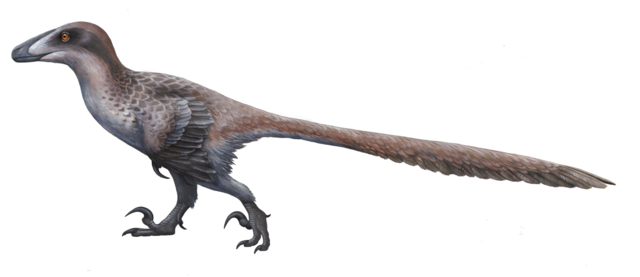Top Qs
Timeline
Chat
Perspective
Cloverly Formation
Geological formation in the United States From Wikipedia, the free encyclopedia
Remove ads
The Cloverly Formation is a geological formation of Early and Late Cretaceous age (Valanginian to Cenomanian stage) that is present in parts of Montana, Wyoming, Colorado and Utah in the western United States. It was named for a post office on the eastern side of the Bighorn Basin in Wyoming by N.H. Darton in 1904.[1][2] The sedimentary rocks of formation were deposited in floodplain environments and contain vertebrate fossils, including a diverse assemblage of dinosaur remains. In 1973, the Cloverly Formation Site was designated as a National Natural Landmark by the National Park Service.[3]
Remove ads
Stratigraphy
Summarize
Perspective
The Cloverly Formation rests disconformably on the Morrison Formation and is conformably overlain by the Thermopolis Shale. It is subdivided into a variety of members, depending on the location.[2][4] In the Bighorn Basin along the Montana-Wyoming border, Moberly (1960) divided the Cloverly into the following three members:
- The Pryor Conglomerate lies at the base and contains abundant black chert. It is named from thick beds exposed on the west side of the Pryor Mountains.
- The Little Sheep Member lies in the middle and is composed of pale-purple, gray to almost white, bentonitic mudstone.
- The uppermost unit is the Himes Member, which contains some coarse-grained channel sandstone deposits, but consists primarily of brightly multicolored (variegated) mudstones.
In contrast, Ostrom (1970) divided the formation into four units, which he named Units IV-VII:
- Unit IV equates to the Pryor Conglomerate of Moberly and consists of a conglomerate or conglomeratic sandstone.
- Unit V, overlaying Unit IV, consists of a lower grey-to-purple claystone with abundant fist-sized chalcedony and barite concretions; the unit is highly bentonitic and contains occasional channel sands.
- Unit VI is a discontinuous "salt and pepper" cross-stratified channel sandstone with occasional conglomerate, considered by Moberly to be part of the Himes Member.
- Unit VII, the uppermost, is a maroon to orange claystone with occasional highly rounded and polished pebbles of silica.[5]
Remove ads
Age
A stratigraphic revision of the Cloverly Formation using new uranium lead dates reinterpret the formation as spanning the Valanginian-Cenomanian stages of the Cretaceous period. The individual ages of the members are listed below:[6]
- Pryor Conglomerate; 140-130 Ma (Valanginian-Hauterivian)
- Little Sheep Member; 130-124 Ma (marine section) (Hauterivian-Barremian) and 124-109 Ma (terrestrial section) (Barremian-Albian)
- Himes Member; 109-98 Ma (Albian-Cenomanian)
Remove ads
Depositional environment
The sediments of the Cloverly Formation were deposited in alluvial and floodplain environments. The basal conglomerates probably represent braided river deposits, while the sandstones were deposited in fluvial channels. The mudstones that contain most of the fossils represent overbank, lacustrine, and pedogenic deposits.[2][4][7]
Vertebrate fauna
Summarize
Perspective
Animals recovered include the dinosaurs Deinonychus, Microvenator, Tenontosaurus, Zephyrosaurus and Sauropelta as well as fragmentary remains of Titanosaurs, Ankylosaurs and Ornithomimids. As well, two genera of turtle Naomichelys and Glyptops and the lungfish Ceratodus.[8] Dinosaur eggs have been found in Montana.[9]
References for data: Ostrom 1970; Cifelli et al. 1998; Cifelli 1999; Nydam and Cifelli 2002. Possible goniopholidid remains are known from the formation.
Dinosaurs
Ornithischians
Ankylosaurs
Ceratopsians
Ornithopods
Saurischians
Theropod eggshell fragments are known from the formation. Unidentifiable ornithomimid remains are present and most commonly represented by toe bones.[10] Indeterminate allosauroid remains are known from the formation. Remains identified by John Ostrom as Ornithomimus are suspected by Jack Horner to be of a new ornithomimid genus.[10] Possible remains of a microraptorian, a troodontid, and a basal tyrannosauroid similar to Moros have also been found here as well.
Color key
|
Notes Uncertain or tentative taxa are in small text; |
Sauropods
Theropods
Mammals
Crocodyliforms
Turtles
Lepidosaurs
Amphibians
Bony fish
Cartilaginous fish
Remove ads
See also
Footnotes
References
Wikiwand - on
Seamless Wikipedia browsing. On steroids.
Remove ads












